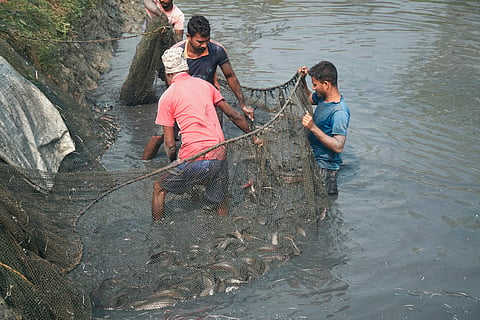WAAW 2024: A multifaceted approach is needed to combat AMR in aquaculture
Antimicrobial resistance (AMR) occurs when microorganisms like bacteria, fungi and viruses adapt over time and no longer respond to antimicrobials used to treat the infections caused by them.
AMR is a growing global health crisis that poses significant threats to human, animal, and environmental health with far-reaching consequences due partly to the undermentioned reasons:
Ineffective treatment: When pathogenic bacteria become resistant to antibiotics, common infections can become difficult or impossible to treat. This can invariably lead to prolonged illness, severe infections, increased hospitalisation, and even death.
Impact on healthcare: AMR can complicate medical procedures like surgeries, cancer therapies, and organ transplants, as the risk of nosocomial infection increases leading to severe post-treatment complications.
Spread of resistant infections: Resistant bacteria can spread easily within communities and healthcare settings, making it harder to control and confine the outbreaks.
Economic burden: Treating resistant infections is more expensive and time-consuming.
Threat to food security: AMR makes it harder to treat infections in livestock, poultry, aquatic animals and plants, potentially leading to food scarcity and inflation.
‘One-Health’ perspective
‘One-Health’ is an approach that recognises the interconnectedness of human, animal (terrestrial and aquatic), plant and environmental health to address health challenges that affect all species.
As AMR is a complex, multifaceted issue that arises from the interactions between these different sectors, inadequate communication and coordination between the sectors can further exacerbate the issue.
Addressing AMR through ‘One-Health’ can implement strategies to reduce antimicrobial use, improve infection prevention, and promote responsible drug use.
Antimicrobial resistance and aquaculture
Aquaculture is the fastest-growing food production sector, producing more than half of the world’s fisheries. It offers food and nutritional security by providing a nutritious protein source and reducing the need to catch more wild fish.
It also provides ample employment opportunities and holds environmental benefits like a smaller carbon footprint than other farming sectors and restoration of aquatic biodiversity.
While increased aquaculture production is associated with semi-intensive and intensive farming practices, diseases and subsequent use of antimicrobials are linked to these farming systems.
Antimicrobial use in aquaculture exerts selective pressures, driving the selection of AMR microbes.
In addition to antimicrobial use, the presence of AMR or antimicrobial resistance genes (ARGs) in aquatic systems is linked to many factors, including coastal runoff of AMR bacteria, antimicrobials, pesticides, and heavy metals from terrestrial sources through improper solid waste disposal, agricultural runoff of pesticides, poorly treated hospital effluents and improper wastewater treatment.
For example, Staphylococcus aureus, Escherichia coli and several Vibrio spp. isolated from freshwater and marine farmed fish and shrimp were found to be resistant to antibiotics like cefoxitin, erythromycin, cefpodoxime, and ciprofloxacin at varying levels, whereas, these antibiotics are not used in aquaculture.
Hence, it is pertinent to emphasise that the presence of AMR or ARGs in aquatic ecosystems is not always related to antimicrobial usage in fish farming.
Effective AMR surveillance systems must integrate data across different sectors to identify patterns of resistance and the movement of resistant strains.
Presently, there is limited comprehensive data available on AMR prevalence in the livestock and aquaculture sector of India. Available data are stand-alone reports without Pan-India coverage and with a low sample size.
Accordingly, the Indian Council of Agriculture Research (ICAR) with technical support from FAO (Food and Agriculture Organization) has formed the Indian Network for Fisheries and Animal Antimicrobial Resistance (INFAAR), a network of 31 laboratories across India, to accelerate a structured laboratory-based surveillance of AMR in India's livestock and aquaculture sectors, aiming to identify patterns of resistance and the movement of resistant strains and to quantify the AMR burden in food-producing animals.
Ways to mitigate AMR in aquaculture
To address AMR in Indian aquaculture, a multifaceted approach is needed:
Responsible antimicrobial use: These include encouraging aquaculture professionals and farmers to use antibiotics only in necessity and by following the specific guidelines. Presently there are no guidelines for responsible use of drugs in aquaculture. Further, data are lacking on biosafety, withdrawal period, efficacy, and pharmacokinetics of the approved aquaculture drugs on most tropical aquaculture species. The ‘All India Network Project on Fish Health’, funded by ICAR, aims to develop policy guidelines on responsible antimicrobial use in the Indian aquaculture sector, addressing the research on these lacunae.
Alternative to antibiotics: An immediate strategy in mitigating AMR burden is the application of antimicrobial alternatives, like probiotics, herbal-derived antibacterial agents, phages, etc.
Vaccination: Developing vaccines for the most prevalent and economically significant aquatic pathogens would overcome the occurrence of diseases and thereby application of antimicrobial agents in aquaculture.
Improved farm management practices: Implementing strict biosecurity measures, promoting good farm management practices such as rotational farming, optimal stocking densities, ensuring water quality and regular health monitoring can reduce stress and disease incidences and thus reduce the need for antimicrobials.
Improved environmental management practices: Proper waste management strategies can minimize the spread of antibiotics and AMR microbes into water bodies.
Education and training for farmers: Aquaculture practitioners need training programs and awareness campaigns to educate on AMR and best management practices for immediate AMR containment.
Research and innovation: Encouraging investment in research to develop novel treatments, early disease diagnosis and control methods can offer more alternatives to antibiotics.
National and global collaboration: Collaboration among governments, academia, and industry is crucial for effective AMR prevention and control.
In conclusion, AMR is a complex issue with far-reaching consequences for human, animal, and environmental health. The ‘One-Health’ approach provides a framework for addressing AMR by recognising the interconnectedness of these sectors.
It is pertinent to emphasise that the presence of AMR or the occurrence of ARGs in aquatic pathogens is not always related to antimicrobial usage in fish farming.
However, implementing responsible antimicrobial use practices, improving biosecurity, farm and environmental management measures, promoting vaccination, and strengthening surveillance and monitoring systems are critical to mitigate the threat of AMR in aquaculture.
Views expressed are the author’s own and don’t necessarily reflect those of Down To Earth.

